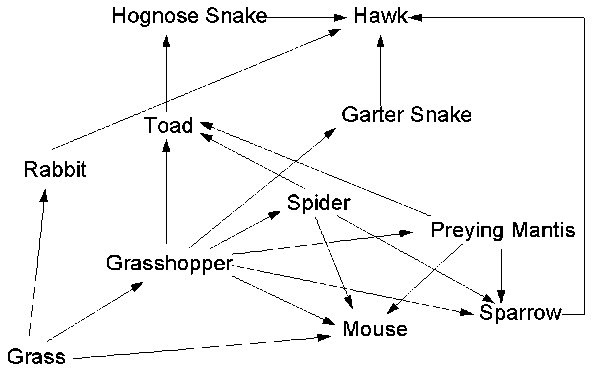
| Palaeos |  |
Ecology |
| Life | Trophic Levels and Groups |
| Page Back: Biota | Page Up: Life | Unit Home | Page Next: Guilds |
| Unit Back: Systematics | Unit Up: Life | Unit Up: Palaeos | Unit Next: Astrobiology |
| Life
Evolution Paleontology Systematics Astrobiology Life on Earth |
Biomes
Biota Trophic Levels and Groups Trophic Levels Trophic Groups Guilds Glossary References |
This page briefly covers a few basic concepts about trophic (= feeding) interactions between organisms and lists some typical trophic positions in the food chain.
Trophic Levels: an introduction to food chains and food webs.
Trophic Groups: a list of typical trophic "jobs" in an ecosystem.


Trophic means eating. Life is the result of the exchange of energy, which - except for the primary producers, (autotrophs - manufacture own food) has to come from consuming other living or dead organisms or organic matter (heterotrophs - derive food from elsewhere). The result, especially when heterotrophs are preyed upon by other heterotrophs, is a food chain. Energy flows through the system from the primary producers through a chain of consumers. Because energy loss can be anywhere from 20 to 90% per successive link or level in the chain, food chains tend to have relatively few links.
At the bottom of the food chain are humble organisms like green plants and photosynthetic algae (or, during the Archean era, when the atmosphere contained little or no free oxygen, anaerobic prokaryotes). Feeding on them are microscopic and macroscopic herbivores, with carnivores preying on them. At the top of any food-chain is the most charismatic creature, the animal that eats others but is not itself preyed upon, the dominant or top predator, sometimes called the superpredator, the lord of all it surveys. Quaternary examples include in today's world the Great White Shark (Carcharodon) and Killer Whale (Orca), the big cats and great bears. Today, man is the real superpredator predator of the Quaternary epoch. In the Mesozoic top predators included the biggest theropod dinosaurs on land, and pliosaurs and mosasaurs in the seas. During the Cambrian period, some 530 million years ago, the top predator was a 60 cm long monster called Anomalocaris, that terrorized the seas for millions of years. Life is ever changing.
At each level of the food chain, organisms compete for food and resources. Based on their mode of feeding, they can be referred to one or more of a dozen or so Trophic Groups. Representatives of each group can further be characterized in terms of guilds. MAK990706
Reference: Benchley and Harper 1998
Organisms, based on their mode of feeding, can be referred to a small number of trophic groups:
Primary Producers - produce food from sunlight (photosynthesis) or chemical reactions (plants, photosynthetic and chemautotropic bacteria)
Herbivores - feed on living plants. They include
Frugivore - feeds on fruit only
Nectivore - feeds on nectar or pollen - e.g. hummingbird
Carnivores (Predators) - capture, kill, dismember (usually), and feed on live prey.
Subdivisions include:
Omnivore - feeds on animals or plants, generally anything it can find
Scavengers - consume dead and/or partially decayed organisms. Most tetrapod predators will also scavenge (generally easier than tackling a live and fighting prey)
Parasites - feed on another (usually larger) organism (whether plant or animal) without (usually) killing it. Two kinds:
Ectoparasites (External parasites) - latch onto target organism and suck the blood or fluid. After it has had its fill it withdraws. Not fatal unless carry disease (e.g. leeches, mosquitoes, ticks)
Endoparasites (Internal Parasites) - permanently live inside the body of, and consume the fluids or issues of another organism (called the host organism), generally over a period of time. A badly evolved parasite will kill its host (and hence itself dies, unless it can find a new host).
Filter Feeder or Suspension Feeder (aquatic environment only) - collect particulate matter or microorganisms from suspension in the water without need to subdue or dismember the particles. Food may include smaller swimming or floating organisms (nekton and plankton), microorganisms, dissolved organic colloidal molecules, organic detritus, living or dead smaller members of benthic flora and fauna, and/or rich organic grains. Especially among invertebrates, this is one of the most common trophic groups. While ciliate microorganisms, rotifers, brachiopods, and bivalves use beating cilia, cirra, or lophophore to sweep particles into their mouth, larger animals may have some sort of sieve to select small organisms from the water (e.g. whalebone in baleen whales)
Detritivores - feed on decaying organic matter in the soil - e.g. millipede
Deposit-feeders (marine) - collect particulate matter from the sediment
Decomposer - breaks down decaying organic matter - e.g. fungi, bacteria
Reference: the above list is modified from Benchley and Harper 1998
MAK010508
| Page Back | Unit Home | Page Top | Page Next |
